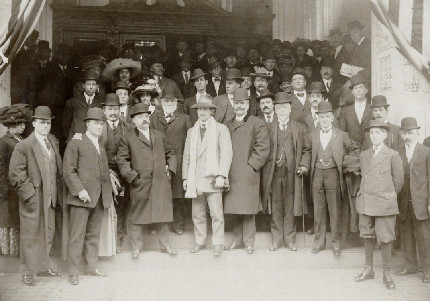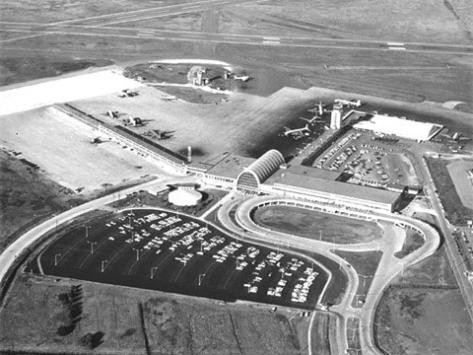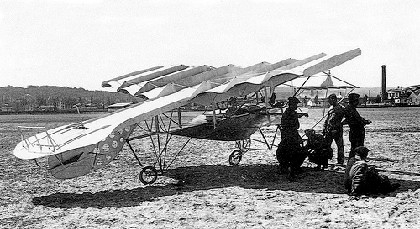
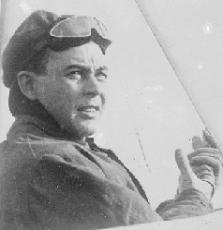
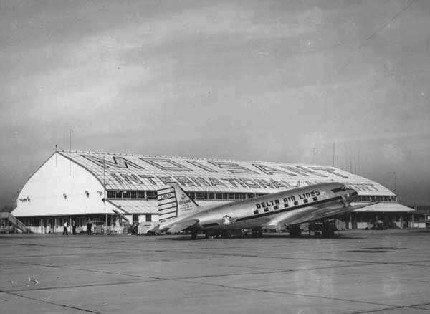
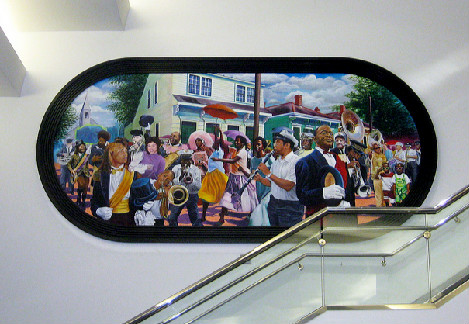
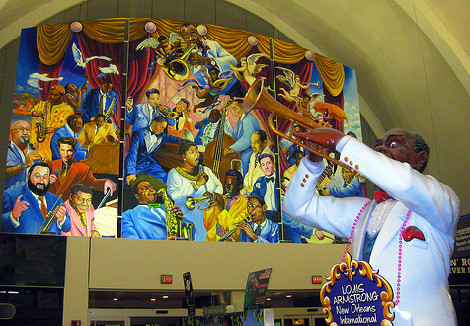
| Mr. Moisant's Fateful Visit |
| Pioneer aviator John Bevins Moisant (center) is pictured with New Orleans city officials on the steps of Gallier Hall, December, 1910. |
There was great excitement in New Orleans on New Year's Eve, 1910. A troupe of daring, high-flying
aviators had arrived for an exhibition of their miraculous flying machines. According to "Contact: The
Story of Early Birds - Man's First Decade of Flight" by Henry Villard, the train delivering the troupe bore
close resemblance to a circus train, complete with big-top tent, roustabouts, ticket-sellers and press
agents, a dozen airplanes with mechanics, its own repair shop and eight bigger-than-life, dare-devil
aviators.
Huge crowds gathered on December 30th and 31st at City Park Racetrack, where the event was being
held. On the 30th, the crowd was rewarded by the unique experience of watching a Packard automobile
and a biplane compete in a race (the Packard won). Excitement started building when it was learned
that, on the 31st, one of the famed aviators, John Moisant, would be attempting to win the 1910 Michelin
trophy for non-stop distance. He would have to break a French record of 362 miles in 7 hours and 48
minutes, set only the day before. The plan was in place and, accompanied by enthusiastic cheers, Mr.
Moisant took off from City Park for the short flight to an area better suited to his mission, a more
unpopulated area in nearby Kenner, where he hoped to remain in the air long enough to win the Michelin
Cup.
A crowd had gathered on the field in Kenner and eagerly watched as the monoplane approached and
began to make its descent, so that it could immediately take off again in pursuit of the trophy. But the
crowd's gaiety turned to horror while they watched helplessly as a sudden gust of wind up-ended the
small plane and John Moisant, thrown from his seat, plummeted to the ground. He was rushed to Charity
Hospital, but was pronounced dead on arrival. Mr. Moisant is buried in the Portal of Folded WIngs Shrine
to Aviaton, in Burbank, CA, the burial site of thirteen great aviation pioneers.
New Orleanians were saddened over the death of the daring aviator. It was only natural, some time
later, when the empty field where the crash had occurred was turned into stockyards, that his name
would be memorialized by the owners. So it was that the Moisant Stock Yards came into being, named
after the pioneer aviator who had been the first to build an all-metal plane, the first to form a
barn-storming exhibition troupe in the U.S. and who had died so tragically on New Year's Eve, 1910 in
that very field.
Years went by and, eventually, the stockyards disappeared to make way for a brand new airport to
serve metropolitan New Orleans. When it opened in 1946, it was decided to name the airport in John
Moisant's honor, Moisant International Airport. Although the name of the airport was changed years
later, first to New Orleans International Airport and then to Louis Armstrong New Orleans International
Airport, the name of Moisant has not disappeared altogether. If you've ever wondered what the airport's
three letter identifier, "MSY," stands for, you may be surprised to learn that abbreviation goes back to the
first use made of the field after the accident of 1910: "Moisant Stock Yards." -- Nancy
aviators had arrived for an exhibition of their miraculous flying machines. According to "Contact: The
Story of Early Birds - Man's First Decade of Flight" by Henry Villard, the train delivering the troupe bore
close resemblance to a circus train, complete with big-top tent, roustabouts, ticket-sellers and press
agents, a dozen airplanes with mechanics, its own repair shop and eight bigger-than-life, dare-devil
aviators.
Huge crowds gathered on December 30th and 31st at City Park Racetrack, where the event was being
held. On the 30th, the crowd was rewarded by the unique experience of watching a Packard automobile
and a biplane compete in a race (the Packard won). Excitement started building when it was learned
that, on the 31st, one of the famed aviators, John Moisant, would be attempting to win the 1910 Michelin
trophy for non-stop distance. He would have to break a French record of 362 miles in 7 hours and 48
minutes, set only the day before. The plan was in place and, accompanied by enthusiastic cheers, Mr.
Moisant took off from City Park for the short flight to an area better suited to his mission, a more
unpopulated area in nearby Kenner, where he hoped to remain in the air long enough to win the Michelin
Cup.
A crowd had gathered on the field in Kenner and eagerly watched as the monoplane approached and
began to make its descent, so that it could immediately take off again in pursuit of the trophy. But the
crowd's gaiety turned to horror while they watched helplessly as a sudden gust of wind up-ended the
small plane and John Moisant, thrown from his seat, plummeted to the ground. He was rushed to Charity
Hospital, but was pronounced dead on arrival. Mr. Moisant is buried in the Portal of Folded WIngs Shrine
to Aviaton, in Burbank, CA, the burial site of thirteen great aviation pioneers.
New Orleanians were saddened over the death of the daring aviator. It was only natural, some time
later, when the empty field where the crash had occurred was turned into stockyards, that his name
would be memorialized by the owners. So it was that the Moisant Stock Yards came into being, named
after the pioneer aviator who had been the first to build an all-metal plane, the first to form a
barn-storming exhibition troupe in the U.S. and who had died so tragically on New Year's Eve, 1910 in
that very field.
Years went by and, eventually, the stockyards disappeared to make way for a brand new airport to
serve metropolitan New Orleans. When it opened in 1946, it was decided to name the airport in John
Moisant's honor, Moisant International Airport. Although the name of the airport was changed years
later, first to New Orleans International Airport and then to Louis Armstrong New Orleans International
Airport, the name of Moisant has not disappeared altogether. If you've ever wondered what the airport's
three letter identifier, "MSY," stands for, you may be surprised to learn that abbreviation goes back to the
first use made of the field after the accident of 1910: "Moisant Stock Yards." -- Nancy
| Left, John Moisant; right, Moisant's plane, 1910 |
| Moisant Airport, above, 1946; below, 1960 |
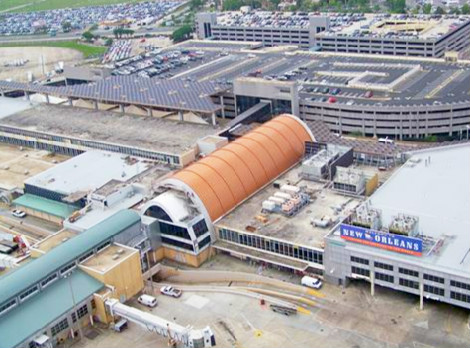
| Louis Armstrong New Orleans International Airport, 2011 |
| Today, Satchmo welcomes visitors to the airport and murals of jazz greats, above, a depiction of a second line, below, as well as other murals, adorn the walls of the airport There's an audio welcome, too, as jazz is played on the airport's public address system. |
| The two photographs directly above are courtesy of WallyG and Flickr Creative Commons. The link to this page is: http://old-new-orleans.com/NO_Moisant.html Back to Old New Orleans The Past Whispers - Home |
